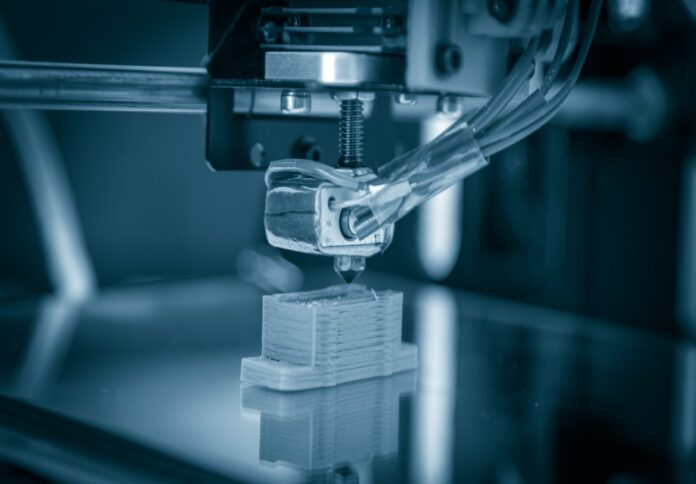
Article by Bill Hennessey, President, ALIO Industries
Additive manufacturing is disrupting the manufacturing paradigm by fundamentally altering the traditional subtractive process of material removal.
Instead of cutting, drilling, moulding or machining raw materials, additive manufacturing builds objects layer by layer, directly from digital designs. This approach reduces waste, allows for complex geometries impossible with traditional methods, accelerates prototyping, and customizes production, revolutionizing industries by enabling rapid, efficient, and on-demand creation of intricate parts and products.
As additive manufacturing evolves into a production technology, precision and repeatability become increasingly crucial factors. In prototyping, minor deviations might be acceptable, but in production, consistency and accuracy are paramount. Precise layer-by-layer material deposition ensures that complex geometries are faithfully reproduced, meeting stringent design specifications. Moreover, as industries like aerospace, medical devices, and automotive rely on additive manufacturing for end-use parts, components must meet tight tolerances to ensure safety, performance, and compatibility within larger systems.
Repeatability guarantees that each part manufactured is virtually indistinguishable from the next, essential for assembly line integration and quality control. This consistency minimizes errors, reduces waste, and streamlines production processes. As additive manufacturing gains traction in fields with high-volume manufacturing demands, such as consumer goods and electronics, the ability to consistently replicate intricate and intricate structures amplifies the technology’s viability as a reliable alternative to traditional manufacturing methods.
The Role of Motion Control
Ultra-precise motion control systems are integral components within additive manufacturing machines, playing a critical role in achieving the high levels of precision required for producing complex and functional end-use parts. These systems govern the movement of print heads, build platforms, and other critical components with microscopic accuracy, ensuring that material deposition is exact and consistent across each layer of the printed object. By tightly controlling movements and positions, these systems minimize deviations and errors that could compromise the final product’s quality.
In additive manufacturing, precision is essential to create intricate structures, maintain fine tolerances, and achieve optimal surface finishes. Ultra-precise motion control systems contribute to precision by facilitating intricate adjustments, enabling rapid changes in direction and speed, and dynamically responding to real-time feedback from sensors. These systems eliminate the potential for vibrations, oscillations, or jitters that might degrade print quality. Furthermore, they enable additive manufacturing machines to compensate for variations in material properties, environmental conditions, and other factors that could impact the outcome of the printing process.
The seamless coordination of ultra-precise motion control systems with other critical components, such as advanced sensors and real-time monitoring, ensures that each layer of material is deposited with exceptional precision, resulting in complex geometries, functional prototypes, and end-use parts that meet the stringent requirements of industries embracing additive manufacturing for production purposes.
The Motion Control Relationship
An additive manufacturing machine manufacturer relies heavily on their motion control technology supplier to deliver a range of critical components and capabilities. First and foremost, precision is paramount. The supplier must offer motion control systems capable of nanometer-level precision to ensure that intricate layers of material are deposited with impeccable precision, allowing the creation of complex geometries and intricate details that meet exacting design specifications. This precision guarantees the production of high-quality end-use parts.
Additionally, repeatability is essential for consistent results in additive manufacturing. The motion control technology should provide exceptional repeatability, enabling the production of identical parts across different manufacturing runs. This consistency is crucial for industries like aerospace and medical devices, where quality assurance and regulatory compliance are of highest importance. The supplier must also offer advanced closed-loop feedback systems, integrating sensors and real-time monitoring to ensure that any deviations or errors are promptly detected and corrected during the printing process.
Furthermore, adaptability and scalability are key considerations. The additive manufacturing industry is rapidly evolving, with machines becoming larger, faster, and more sophisticated. The motion control technology supplier must offer solutions that can accommodate various machine sizes and types, seamlessly integrating with evolving printer architectures. This adaptability is essential as manufacturers seek to optimize productivity, reduce downtime, and accommodate new materials and processes. Lastly, collaboration and support are critical aspects. A reliable supplier should offer comprehensive technical support, training, and a partnership mindset, enabling manufacturers to optimize the integration of motion control systems into their additive manufacturing machines, ultimately contributing to the success of their products in the market.
Motion Control – The Specifics
Additive manufacturing machines typically employ a combination of linear stages, gantries, rotary stages, and multi-axis systems to control the positioning of print heads, build platforms, and other critical elements.
Linear Stages. High-precision linear stages are a critical component in additive manufacturing machines, facilitating controlled and precise movement along straight paths. These stages employ advanced technologies such as precision linear bearings, ball screws, and linear direct drives to ensure smooth and accurate translation of print heads or build platforms. By maintaining tight tolerances, these stages guide the deposition process with exceptional precision, allowing for consistent layer-by-layer material placement.
In additive manufacturing, accurate layer deposition is vital to achieving the desired object’s geometry and structural integrity. High-precision linear stages play a pivotal role in ensuring that each layer of material is positioned accurately based on the digital design. This level of control minimizes deviations and errors, resulting in printed parts that match the intended specifications. Whether it’s the intricate details of a complex model or the precise alignment of critical features, the capability of high-precision linear stages to enable controlled movement along straight paths significantly contributes to the reliability and quality of additive manufacturing processes.
Gantries. Gantries achieve highly accurate and controlled movements in industrial applications such as additive manufacturing. They serve the critical role of precisely positioning various components, such as print heads, build platforms, or other tools, in a coordinated manner during manufacturing processes. By executing intricate motion paths with minimal deviations, gantries ensures that the deposition of materials or the manipulation of objects follows predetermined trajectories with micron- or sub-micron level precision. This level of control contributes to producing complex and accurate 3D-printed objects, enhancing product quality, dimensional accuracy, and overall manufacturing efficiency.
Rotary Stages. A rotational correction is a common feature within additive manufacturing machines. These stages are designed to rotate objects or components with exceptional accuracy, making them well-suited for applications like continuous 360-degree printing, where cylindrical objects or structures require uniform coverage. Rotary stages allow the print head or material deposition mechanism to apply material around the entire circumference of the object, ensuring even distribution of material and consistent layer deposition.
Furthermore, rotary stages enable precise angular adjustments in additive manufacturing processes. Objects with intricate geometries, overhangs, or complex contours often necessitate controlled rotation to enable the deposition of material at specific angles. Rotary stages provide the necessary flexibility to position the object accurately, allowing the material to be deposited in alignment with the intended design, resulting in high-quality prints with intricate features and precise details. The versatility of rotary stages in enabling both continuous rotation and precise angular adjustments significantly enhances the capabilities of additive manufacturing machines, enabling the production of a wide range of complex parts and components.
Multi-Axis Systems. Multi-axis systems play a pivotal role in enabling complex and intricate movements. These systems involve multiple coordinated axes of motion, allowing for simultaneous control of translation, rotation, and even tilting of components. Multi-axis configurations are particularly important for producing objects with overhangs, undercuts, and complex geometries, as they provide the necessary flexibility to deposit material at various angles and orientations. These systems are crucial in ensuring that the printed structures maintain their integrity and quality throughout the printing process.
Closed Loop Feedback. Closed-loop feedback mechanisms are integral to motion control systems in additive manufacturing machines. These systems incorporate sensors, encoders, and real-time monitoring to continuously measure and correct deviations from the desired positions. By providing immediate feedback to the control system, closed-loop systems minimize errors and inaccuracies, ensuring that the printed objects adhere to precise design specifications. As the additive manufacturing industry advances, motion control systems continue to evolve, integrating advanced technologies such as predictive algorithms, machine learning, and adaptive control strategies to further enhance precision, speed, and overall performance during the printing process.



















